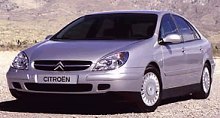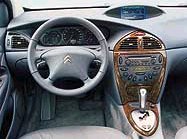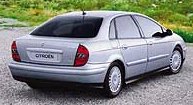 The
successor to Xantia has little family resemblance. It doesn’t look like
the Bertone Citroens - BX, AX, ZX, XM and Xantia, neither does it look
like the golden age Citroens - DS, GS and CX. The cab-forward design
looks
somewhat like Picasso, but less handsome, while you can also find
similar
profile in any Chrysler. Anyway, compare with Xsara this new car is
still
more distinctive. If it doesn’t look as futuristic as the company used
to be, at least it does look fresh. The same thing can’t be said to
Xsara. The
successor to Xantia has little family resemblance. It doesn’t look like
the Bertone Citroens - BX, AX, ZX, XM and Xantia, neither does it look
like the golden age Citroens - DS, GS and CX. The cab-forward design
looks
somewhat like Picasso, but less handsome, while you can also find
similar
profile in any Chrysler. Anyway, compare with Xsara this new car is
still
more distinctive. If it doesn’t look as futuristic as the company used
to be, at least it does look fresh. The same thing can’t be said to
Xsara.
As usual, we are going to start our examination from tape measure. This car is rather big by class standard. It is some 184 mm longer and 100 mm higher than Xantia, although wheelbase has grown just 10 mm from the already outstanding 2740 mm. Therefore you can expect similar interior room as the new Mondeo. Sit inside and you might be fooled by its cab-forward windscreen, very high roof and airy ambience thanks to large glass area. However, in fact the rear legroom is just average, especially front seat backs are very thick. That’s good to the front occupants, because the French-style front seats provide the right balance between comfort and support.
It is unsurprising that the car is derived from a platform shared with various PSA models, including Peugeot 607, the forthcoming 407 and Citroen C6. No wonder the car is substantially bigger than before. Unlike Volkswagen and GM, PSA’s platform sharing strategy is looser, that means many equipment and powertrains are shared but not necessarily including suspensions and the exact floorpan. In fact, the continuing adoption of Hydropneumatic suspension instead of conventional coil springs and dampers is very crucial to retain Citroen’s traditional ride character. Moreover, the company won’t let its years of investment in Hydractive system wasted. Now the latest Hydractive 3 has made its debut in C5. Hydractive 3
In reality, the new system works much better than before. The softness of Xantia or XM has been replaced by a firmer setting. It adapts itself to absorb bumps very well, providing a flying carpet-like ride especially at high speed. Most of the time this is the most comfortable ride in class, although it is still not perfect - sharp and high frequency bumps may fool its electronics, generating unwanted reactions. Perhaps it is still not reacting quick enough. Handling One of the tradition failure of Citroen is lack of steering feel, perhaps due to Hydropneumatic as well. In C5 this is still unsolved. Although it is actually pretty accurate and well weighted, it feels vague. The Hydractive 3 cannot help involvement as well. Perhaps it works too well, it isolates the car from any intrusion on the road thus let the driver feels remote. Objectively, however, the car handles quite competent. It just provides little feedback so that you have to try its limit and build confidence on experience. If so, it can be pushed pretty hard in corners, especially the Hydactive firms up to aid attacking corners. Engine and performance
2.0HPi is similar to Mitsubishi’s GDI, neither as refined nor as flexible as the 2.2HDi but its nose carries a massive 130 kg less burden thus is more willing to change direction. In contrast, top-of-the-range V6 is front heavy while performance is not as spirited as expected, somewhat blunted by the ZF 4-speed Tiptronic automatic. Its speed-sensitive power steering is also too light and provide even less feel. Overall speaking,
both 2.2HDi
and 2.0HPi are good cars for family buyers, if not keen drivers. In
this
diesel age, the 2.2HDi is especially attractive. I am sure the C5 will
be another commercially successful car made by the company. However, it
will not be a Citroen you’ll remember 20 years later. In contrast, I
still
remember BX. |
| The above report was last updated on 15 May 2001. All Rights Reserved. |
 Now
comes the dashboard and interior packaging, which scores average marks
in style as well as plastic quality. Again, you have seen similar
things
in some big Chryslers. That said, the Passat, Mondeo and even Laguna
seems
better packaged. Nevertheless, from practicality point of view the
Citroen
rates high - lots of storage space, big boot (you won’t notice that it
is actually a hatchback, just like Xantia or many Citroen sedans),
folding
rear seats, wide range of adjustment to driving position,
steering-column-mounted
stereo and cruise control.
Now
comes the dashboard and interior packaging, which scores average marks
in style as well as plastic quality. Again, you have seen similar
things
in some big Chryslers. That said, the Passat, Mondeo and even Laguna
seems
better packaged. Nevertheless, from practicality point of view the
Citroen
rates high - lots of storage space, big boot (you won’t notice that it
is actually a hatchback, just like Xantia or many Citroen sedans),
folding
rear seats, wide range of adjustment to driving position,
steering-column-mounted
stereo and cruise control.  Remember
Hydractive ? the first generation was introduced by XM in 1989. The
second
generation used by Xantia Activa added hydraulic active anti-roll bar
which
received mixed impression. Now the anti-roll bar thing has gone,
leaving
the system more faithful to the first generation but the hydraulic
system
is more durable (5 years or 125,000 miles maintenance-free) and
electronics
reacts quicker to changes. Most important new feature is adaptive ride
height - admittedly, Porsche 959, Range Rover, Audi Allroad etc. also
employed
that - which drops the body at high speed to reduce drag while increase
stability. Moreover, the front end drops more than the rear so that
more
aerodynamic downforce will be generated. At low speed the ride height
will
be raised. Off road, ground clearance will be further increased to
maximum.
Otherwise the Hydractive 3 functions similar to the 1 and 2. It adapts
damping rate according to driving style (the computer knows that by
reading
data from speed, g-force, throttle, steering wheel sensors) as well as
road conditions (smooth or rough).
Remember
Hydractive ? the first generation was introduced by XM in 1989. The
second
generation used by Xantia Activa added hydraulic active anti-roll bar
which
received mixed impression. Now the anti-roll bar thing has gone,
leaving
the system more faithful to the first generation but the hydraulic
system
is more durable (5 years or 125,000 miles maintenance-free) and
electronics
reacts quicker to changes. Most important new feature is adaptive ride
height - admittedly, Porsche 959, Range Rover, Audi Allroad etc. also
employed
that - which drops the body at high speed to reduce drag while increase
stability. Moreover, the front end drops more than the rear so that
more
aerodynamic downforce will be generated. At low speed the ride height
will
be raised. Off road, ground clearance will be further increased to
maximum.
Otherwise the Hydractive 3 functions similar to the 1 and 2. It adapts
damping rate according to driving style (the computer knows that by
reading
data from speed, g-force, throttle, steering wheel sensors) as well as
road conditions (smooth or rough).  As
the car is big and heavy, performance is limited for all versions.
There
are many engines to choose from - 117 hp 1.8-litre, 138 hp 2.0-litre,
143
hp 2.0HPi direct-injection petrol, 210 hp 3.0 V6, 110 hp 2.0HDi and 136
hp 2.2HDi (with VTG turbine and PSA’s unique particle filter), the last
two are both common-rail diesel. The 2.2-litre HDi is especially star
of
the range, providing flexible acceleration and first class refinement.
Plenty of torque means it usually run at low rpm thus generates less
noise
than petrol engines. Compare with class rivals it is also the quietest
diesel today.
As
the car is big and heavy, performance is limited for all versions.
There
are many engines to choose from - 117 hp 1.8-litre, 138 hp 2.0-litre,
143
hp 2.0HPi direct-injection petrol, 210 hp 3.0 V6, 110 hp 2.0HDi and 136
hp 2.2HDi (with VTG turbine and PSA’s unique particle filter), the last
two are both common-rail diesel. The 2.2-litre HDi is especially star
of
the range, providing flexible acceleration and first class refinement.
Plenty of torque means it usually run at low rpm thus generates less
noise
than petrol engines. Compare with class rivals it is also the quietest
diesel today.